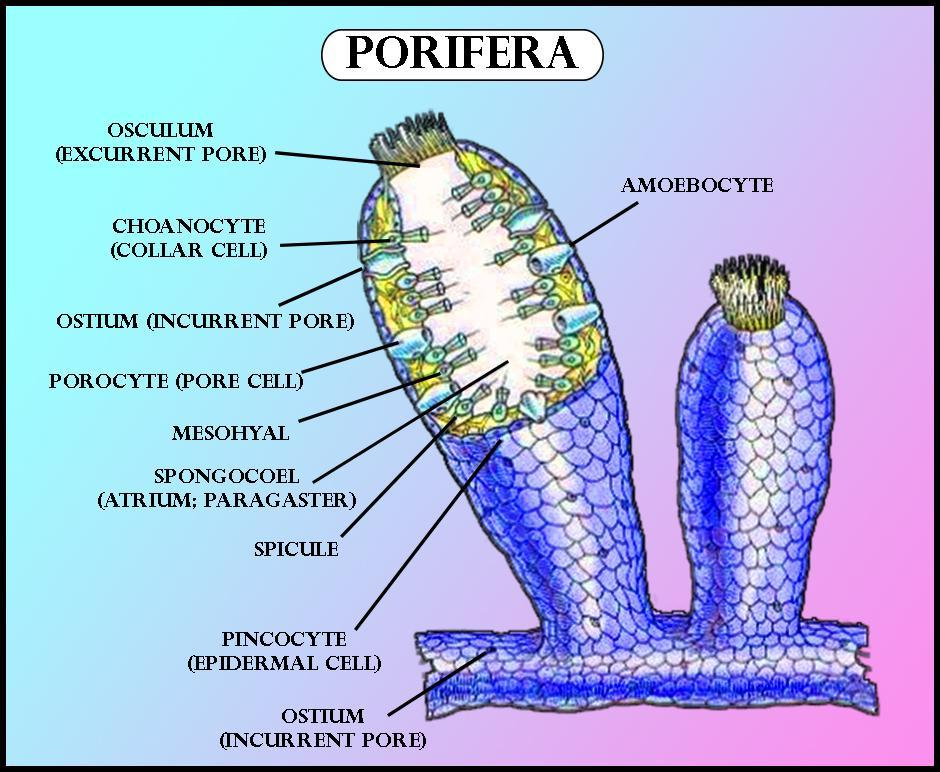
In Porifera, generally pinacocytes are found in
(a) Outer epithelium
(b) Inner epithelium
(c) Mesenchyme
(d) All of the above
Answer
492.9k+ views
Hint: Porifera is generally called sponges. Pinacocytes are the sponges' "skin-cells." They line the external body wall of the sponge. They are thin, tightly packed, and leathery. Pinacocytes retain sponge size and shape through minor expansions and contractions.
Complete answer:
Sponges are diploblastic meaning they only have two layers of embryonic cells, such as ectoderm and endoderm. They do not have mesoderm. The outer ectoderm layer is pinacoderm and the inner endoderm layer is choanoderm. The pinacoderm consists of the cells that are called the pinacocytes, which are similar to the outer epithelium.

Additional Information:
Porifera, with a few freshwater animals, are usually marine aquatic organisms. Their remains are asymmetric. They have a cylindrical body shape, like a vase, rounded, or like a sac. The body has several openings called the ostia, and in the end, there is a single wide opening called the osculum. There are no Sense organs.
Pinacocytes are classified into three types. They are,
Basipinacocytes: These are the cells that are in contact with the substratum of the sponge i.e the surface to which it is attached.
Exopinacocytes: These are found at the sponge’s surface.
Endopinacocytes: These form the internal canals of the sponge.
So, the correct answer is ‘Outer epithelium’.
Note:
The epithelial-like pinacocytes form the outermost layer of sponges and enclose a jelly-like material called mesohyl. Mesohyl is an extracellular matrix composed of a collagen-like gel with suspended cells performing different functions. The gel-like consistency of mesohyl functions as an endoskeleton and retains the sponges' tubular morphology.
Complete answer:
Sponges are diploblastic meaning they only have two layers of embryonic cells, such as ectoderm and endoderm. They do not have mesoderm. The outer ectoderm layer is pinacoderm and the inner endoderm layer is choanoderm. The pinacoderm consists of the cells that are called the pinacocytes, which are similar to the outer epithelium.

Additional Information:
Porifera, with a few freshwater animals, are usually marine aquatic organisms. Their remains are asymmetric. They have a cylindrical body shape, like a vase, rounded, or like a sac. The body has several openings called the ostia, and in the end, there is a single wide opening called the osculum. There are no Sense organs.
Pinacocytes are classified into three types. They are,
Basipinacocytes: These are the cells that are in contact with the substratum of the sponge i.e the surface to which it is attached.
Exopinacocytes: These are found at the sponge’s surface.
Endopinacocytes: These form the internal canals of the sponge.
So, the correct answer is ‘Outer epithelium’.
Note:
The epithelial-like pinacocytes form the outermost layer of sponges and enclose a jelly-like material called mesohyl. Mesohyl is an extracellular matrix composed of a collagen-like gel with suspended cells performing different functions. The gel-like consistency of mesohyl functions as an endoskeleton and retains the sponges' tubular morphology.
Recently Updated Pages
Master Class 12 Social Science: Engaging Questions & Answers for Success

Class 12 Question and Answer - Your Ultimate Solutions Guide

Class 10 Question and Answer - Your Ultimate Solutions Guide

Master Class 10 Science: Engaging Questions & Answers for Success

Master Class 10 Maths: Engaging Questions & Answers for Success

Master Class 9 General Knowledge: Engaging Questions & Answers for Success

Trending doubts
Is Cellular respiration an Oxidation or Reduction class 11 chemistry CBSE

In electron dot structure the valence shell electrons class 11 chemistry CBSE

What is the Pitti Island famous for ABird Sanctuary class 11 social science CBSE

State the laws of reflection of light

One Metric ton is equal to kg A 10000 B 1000 C 100 class 11 physics CBSE

Difference Between Prokaryotic Cells and Eukaryotic Cells




